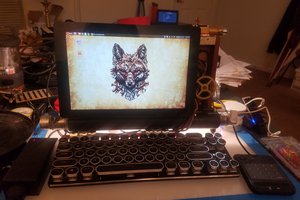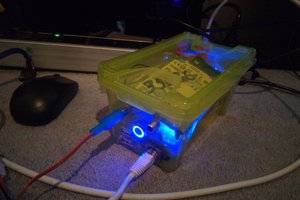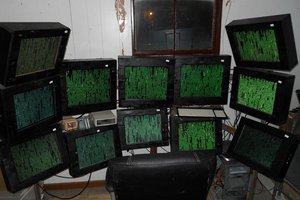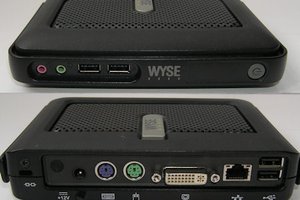The PIII served well really. It is still running in fact. I think the cpu fans died a few years back but when I built it back in the day I put a lot of case fans in it. I think most of them have died over the years too. What kept it going is beyond me.
It's demise if you want to call it that, it is not really a demise, as it is still quite alive, but.. The network topology has changed here and we now have a proper DMZ so no more port forwarding for it. And truthfully, I mostly got tired of thinking that it had a very outdated OS and it sucked a lot of power (120W is my est, as my old desktop at work would idle at 92W and that was a single CPU and had only a single disk not 4, and on board sata, not 2 pci sata mirroring cards). As it turned out a friend gave me a pile of Wyse thin terms, These are odd ducks. They have a little 128mb ide ssd in them and one 512M dim.
When I first fired the thing up, it came up with a windows logon screen. Cool. After some screwing around I discovered that I could break that process by resetting the CMOS via the internal jumper. It would than stop and allow me to hit del to get into setup. Setup scared me as it asked for a password, but this is a factory password: Fireport Later on I discovered that if you are handy with the delete key you may be able to get into setup without cracking the unit open. I wanted to open it up anyway as I wanted to disconnect the wifi radio. I am after power savings after all.
Next I got to learn about tinycore linux. I am not a stranger to little linux. Years ago I was in charge of an international voip pbx. I used low end hp consumer grade pc's for the office servers. This was not as dumb as it sounded. The boxes were like $200, I had an image I could slap on them in minutes, and all of the system replicated to all of the systems and any one could with one little edit, stand in for any or all of the others. There would be slight latency issues depending on what croaked but nothing unreasonable. This let me have spares of everything. And when you are prepared like that, nothing fails.
Anyway, I started with CentOS Single disk server and trimmed and trimmed until I had just what I needed to do what I needed. A very very stripped down Linux with a very strpped down kernal, but it was fast and ran almost no services. So I have sort of a soft spot for small linuxes.
Tinycore if you have not played with it is fun and interesting and tiny. Kudos to the guys behind it, really. I had fun with it.
I got sshd going on it with my cert so I did not have to work in the (unheated) closet that serves as my server room. After that I got lighthttpd going. An easy switch from apache. Next I had to figure out the DMZ, that took little time and I managed to screw up my WLAN in the process, so it took longer than it should have. Back to the little term again to change the IP for the DMZ and a cold trip into the closet to run a wire for it to the firewall. And it was answering on my first try. Cool.
The next big thing was sucking the web out of he old server. I was able to get to it via samba and I made a big tar file on my notebook. I extracted that onto a big USB stick where it got mounted read only on the thin term. A bit more editing to configure the name based virtual hosts and than some screwing around getting my dynamic dns back working and I was sort of on the air..
I was on the air, and it was fast. I was amazed. So was the SO. But, the gadget I wrote 20 years ago to make the web pages mostly just indexed pictures into index files. On the last page of pictures, going forward looped you back to the first page again. For some reason I called the first index index0 and when I was done I created a link from index0.html...
Read more » matthewkleinmann
matthewkleinmann
 Starhawk
Starhawk

 novak
novak